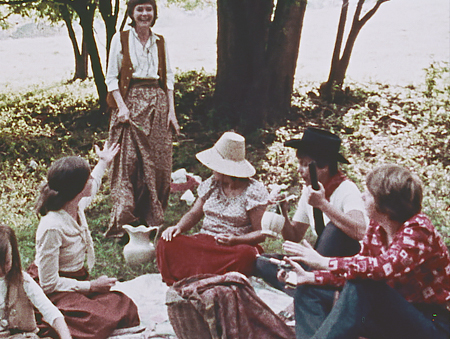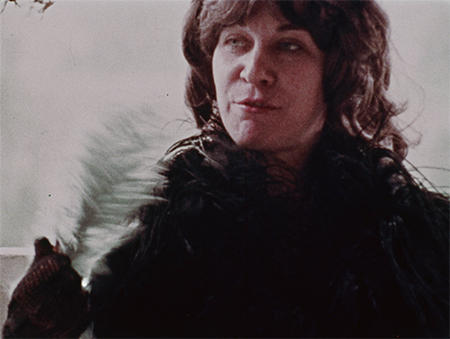Protesters are picketing the Miss America Pageant, and “consciousness-raising” groups springing forth. Demonstrators invade the home of The Playboy Club. Women are forging new ideas about gender roles, self-expression, and sexuality. As Women’s Liberation goes full-tilt boogie, new institutions and new leaders arise. A modern women’s movement is being born.
Pandora opened her box; evils flew free, but Hope remains. She stands with hand outstretched, inviting you to consider all the real and imagined prospects of this burgeoning feminist movement: Is biology destiny? Can you be anything you want? What do you want—to discover a truer self? To break the strictures of gender roles? To shatter glass ceilings?
An all woman cast and crew gathers…
The Women’s Happy Time Commune
1972 16mm release, HD Video, 47 mins
An improvised comedy takes the Old West for its stomping ground…
Digital conservation with help from the Women’s Film Preservation Fund
 It was a lively time, and a time when the relatively low cost of 16mm cameras and film made it possible for many aspiring film-makers to launch their careers. Most chose the documentary route; my efforts were more idiosyncratic: The Women’s Happy Time Commune is fictional— comedy improvised within a loose story framework.
It was a lively time, and a time when the relatively low cost of 16mm cameras and film made it possible for many aspiring film-makers to launch their careers. Most chose the documentary route; my efforts were more idiosyncratic: The Women’s Happy Time Commune is fictional— comedy improvised within a loose story framework.
With an all-woman cast and crew…
The all-woman cast and crew was a first—an inspiration born of the times. People were attracted to such an environment. All involved, actors and production crew, felt their actions were significant—that they were makers of the new Herstory. The context was movie-making and also women-making.
It occurs to me, now, that people came to be in the movie rather as did the animals boarding Noah’s ark: They were excited and had no idea what lay ahead. (Except that unlike the animals who arrived two by two, the actors arrived one by one—and were not compelled to reproduce.)
I can’t remember how I managed to pay for the movie, but before production I do remember raising somewhere around $750 from friends in $50 “shares”. The shoestring budget was stretched to cover purchase of set-dressing supplies, outdated film stocks, and to pay special deals on rented equipment. The generous help and teaching of the many wonderful people running New York City film businesses made everything attainable.
Just before we left town to shoot “Women’s Happy Time”, Phil Pearle of Sound One taught our sound recordist how to use the Nagra recorder, lent us his (superb) Neumann mic, rented us our Arriflex camera, and showed me how to do an electrical tie-in without electrocuting myself. My learning curve was steep and swift. The next day I was in the Virginia countryside— alone in a tiny church loft, lightning cracking and thunder booming as I clamped breaker-box leads to the (thankfully correct) terminals of an ancient power box.
The movie was shot — almost non-stop—over one long summer weekend.
Months later, editing complete, I went to Magno for the sound mix. There, Sol Tabachnick did the job in three hours flat – miraculously holding to what I could pay. His speediness was indeed miraculous because, in my ignorance, I’d left gaps between soundtrack sections. When the first such silence hit— it was as if the projector had suddenly fallen into outer space—Sol turned into a whirling dervish, creating myriad insect-sounds to match and fill the myriad silences, and, all in all, setting a record for speed, efficiency and quality that will never be equaled.
If you’ve noticed that I’ve mentioned two male film pros and no women, that was 1970. The pioneering migration of women and feminist concerns into movie-making was only just beginning. Soon, female role models would sprout like mushrooms—magic circles widening and spreading.
 “The Women’s Happy Time Commune” reflects an era in which many different shades and stripes of women were searching for the enabling wind to fill their new sails. During the making of the movie, its serendipitously assembled players found a safe space in which to explore their feminism and re-imagine themselves.
“The Women’s Happy Time Commune” reflects an era in which many different shades and stripes of women were searching for the enabling wind to fill their new sails. During the making of the movie, its serendipitously assembled players found a safe space in which to explore their feminism and re-imagine themselves.
Do you find that conversations change when the women you know talk just amongst themselves? Do women you know trim their behavior and thoughts to their company? Are they hesitant to speak for themselves and/or to act on their own behalf?
“The personal is political…”
The phrase was a mantra of the times – a phrase meaning that your personal concerns are very likely shared by other women. And that women’s sharing of their concerns would create a new political reality.
But how does political change occur? What good is talk? Does today’s communication media facilitate change?
Is this a political film?
At the time, it was considered a political film— simply because it embodied women’s points of view and women’s stories.
Are today’s public spheres tuned to female points of view? Would it be better if they were more tuned? If they were, what improvements might you see?
Is this a utopian movie?
(No—it’s a comedy.) But utopian or not, 1970 was a big time for “What if…?”
Then and now: Do you want to change the world? What framework of support would you need to create your brave new world?
Gender…
Today, gender identity and gender transition—the potentially fluid nature of sexuality—is thought of as an individual’s dilemma or decision. But in the early 1970s, it was the very air and atmosphere that twitched to a new sense of indeterminacy in gender, gender roles and lifestyles.
If women lived lives without men? If men had a different nature? Does it matter what other people think?
I offer a small list of the books collected in the ’70s: “Awakening and Other Stories”, by Kate Chopin; “Our Bodies, Ourselves” by The Boston Women’s Health Collective; “Going Too Far” by Robin Morgan, editor of “Sisterhood is Powerful”; “The Second Sex” by Simone de Beauvoir; and “Marmelade Me” by Jill Johnston.
Backdrop…
Jeanne Betancourt’s (1974) book, “women in focus” documents feminist film-making in the early 1970s. Betancourt devotes a chapter to Women Make Movies, Inc., the community-based non-profit film workshop* created in 1972 by Ariel Dougherty and Sheila Paige. She profiles the two directors and describes the workshop students, neighborhood women from all stages of life and work making their first 16mm movies – writing story scripts, directing, filming, editing, and participating in community screenings.
(*Today, the organization’s a non-profit distributor of women’s films.)
